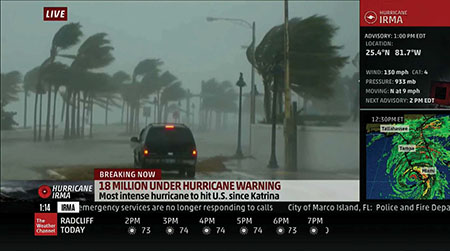SvrWeather.com Covers Irma Via Teradek’s Cloud
SOUTH FLORIDA—I’ve been covering severe weather events and natural disasters for many years and Hurricane Irma was one of the most intense I’ve ever experienced. Storm surge, flooding, 100 mph winds and the mass exodus of residents evacuating southern Florida—it was something the world had to see.
SvrWeather.com delivers live video from extreme weather events to local and major TV news networks for broadcast. You will find us in tornado alley during spring, in the Midwest covering intense winter storms and anything that involves extreme weather conditions. For Hurricane Irma, we were in South Florida covering the preparation, event and aftermath of the hurricane for our ABC affiliate in Kentucky, then redistributing the feeds to The Weather Channel, social media and other major news networks.

Teradek’s Bond+Cube system delivered live coverage of Hurricane Irma.
EYE OF THE STORM
From South Florida, we needed to broadcast a feed from remote locations in the city and on the beach back to the station in Kentucky. We knew this wasn’t going to be an easy task; with a huge hurricane headed right for us, RF signals were going to be an issue. Without industrial satellite trucks, there’s no guarantee our feeds would even reach the destination.
Having used Teradek gear for years, I knew their internet-bonding cloud solution was the answer. I brought a Teradek Bond+Cube system with me—a device that lets us broadcast from the field using 4G/LTE-enabled USB modems. I decided to use two of Teradek’s new Node industrial-strength 4G/LTE USB modems, so when we were ready to broadcast, I’d connect the Bond+Cube/Node to our Canon XA20, plug in the microphone and start reporting.
This is where Teradek’s cloud solution stands apart. Bond streams directly to Teradek’s cloud-based server, Core, which is a platform that enables many options for the video feed. The biggest feature here is it can push the feed to several destinations simultaneously. Using Core, we distributed the feed to the station in Kentucky, You-Tube, Facebook Live and Severestudios.com all while only using the bandwidth of a single stream.
CLOUDY TO CLEAR
From start to finish, the Bond/Node system held up in the most extreme weather conditions. Before the hurricane, we were broadcasting interviews from the beach and other remote areas without a solid internet source. As the hurricane rolled in, we were still able to broadcast HD video to the station and to our partner networks using cellular. Even after the hurricane, when all of our phones lost 4G signals completely, the Node was still picking up a strong 4G/LTE connection, allowing us to provide live coverage of the aftermath.
But the most critical parts were the destinations. Teradek’s Core platform allowed us to send the stream wherever we wanted, giving us full control to manage every aspect of our video. Using Bond/Cube, we were able to use a single stream to get the video to the station. Core was then able to push the stream to several destinations simultaneously, allowing us to cover more networks and reach more eyes.
It was the perfect low-cost solution to provide live coverage on an important breaking news event. As I’m always in the middle of extreme weather situations, I know I can depend on Teradek to help me deliver the news wherever I am.
John Humphress is an extreme weather journalist for SVR Weather. He can be reached atjohn@kycities.com.
For more information, please visitwww.teradek.comor call (888) 941-2111.
Get the TV Tech Newsletter
The professional video industry's #1 source for news, trends and product and tech information. Sign up below.
